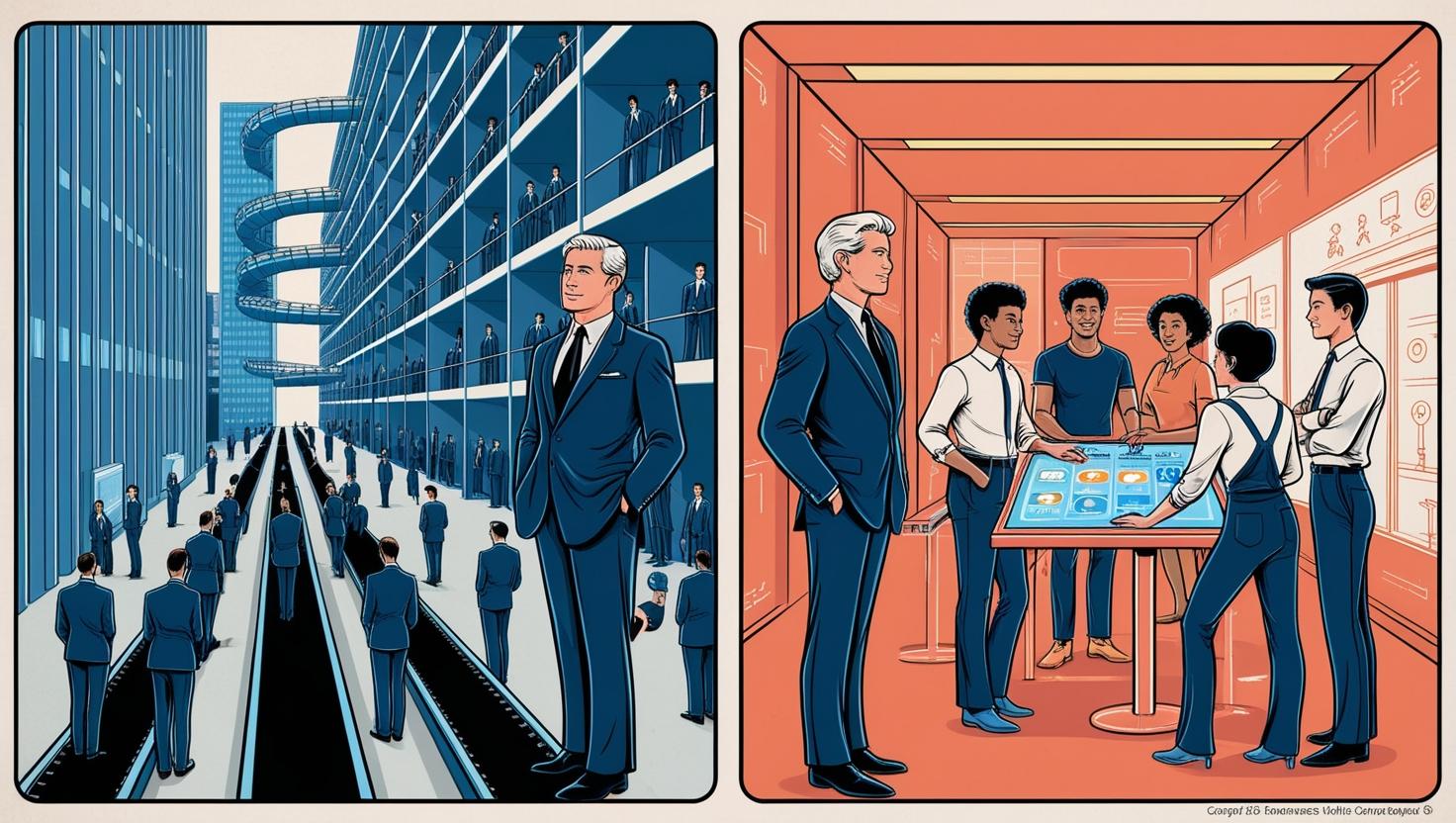Why the Grand Transformation Plan is Dead.
For years, companies have launched huge, multi-year “grand” transformation programs and waterfall-style initiatives intended to overhaul strategy, processes, and technology all at once. In practice, however, these efforts often fell short. Research shows that over 80% of large transformation programs fail to meet their goals. Such initiatives can become overly complex (involving hundreds of technologies and thousands of processes) and drag on for years, by which time markets and priorities have shifted. In short, betting on a one-off “big bang” rarely delivers sustainable results. Transformation must be an ongoing journey, not a fixed endpoint.
Waterfall vs Agile: A Paradigm Shift
The limitations of the waterfall mindset, which involves planning everything up front and executing sequentially, have become clear. In its place, Agile ways of working are taking hold. Agile means breaking work into shorter cycles, learning and adapting as you go, rather than banking everything on a single long-term plan. This shift is already widespread. A KPMG survey found that 81% of organisations have started an Agile transformation in the past three years, reflecting how mainstream the approach has become.

Switching to Agile is not just trendy, it addresses exactly why grand plans stall. Instead of 5-year rollouts, Agile teams can deliver incremental value in months or weeks, continually testing assumptions and adjusting. Rather than pushing through a fixed end-date, Agile teams treat change as a continuous process, precisely the mindset experts now recommend. In practice, this has meant companies refocus on smaller, iterative efforts instead of huge monolithic programs. For example:
- Fast feedback: Agile teams deliver working solutions early (often after just a few sprints) rather than waiting till the very end. This catches problems sooner and avoids the “surprise” that derails big projects.
- Adaptability: Priorities in digital businesses can change overnight. Agile embraces change by design, teams regularly re-prioritize the backlog, whereas waterfall plans have to cancel or scrap work if conditions shift.
- Business engagement: Agile cross-functional squads keep stakeholders involved continuously, whereas traditional transformations often leave employees and leaders in the dark until release.
Overall, the data shows how quickly Agile has spread: by some measures, team-level Agile adoption jumped from about 37% to 86% between 2020 and 2021. In other words, most modern organisations now expect to be working differently, in bite-sized, iterative ways rather than following a rigid year-long plan.
COVID-19: Turbocharging Digital Change
The COVID-19 pandemic proved a real-world stress test. Almost overnight, lockdowns forced companies to pivot to digital and remote models. Remarkably, many organisations succeeded by leaning on agile practices. McKinsey reported that companies stood up workable remote-working solutions in an average of 11 days, a process that pre-COVID they expected would take over a year. That’s about a 40× acceleration of digital change. In short, what would have been a year-long IT rollout was done in a few weeks.

This speed wasn’t just an anomaly – it correlated with performance. In a McKinsey survey, 72% of companies that were quick to adopt new digital technologies in early 2020 rated their own COVID response as good, versus only 33% of slower-moving firms. In practice, the firms that had already started building agile capabilities handled disruption better. Their teams could rapidly reallocate resources, test new solutions, and roll out changes on the fly. By contrast, rigid organisations struggled or stalled under sudden demand.
The bottom line: COVID didn’t break these businesses, it exposed which ones were truly agile. Those that had embraced iterative ways of working could absorb shocks and keep delivering. The lessons have stuck. Today’s leaders know that speed and flexibility matter – and that big, slow programs often can’t keep up. In response, many companies have doubled down on Agile, DevOps and cloud transformations to lock in the gains from that breakneck pivot.
Lessons from New Zealand: Agile in Action
New Zealand organisations provide concrete proof that agility works. For example, the Ministry of Social Development (MSD) credits agile methods with enabling its rapid COVID response. During lockdowns, MSD had to convert its entire service model into digital channels almost overnight. By using multidisciplinary Agile teams and ceremonies, it met new demand (such as wage subsidy payments) far faster than traditional processes would allow. As MSD’s CTO notes, “Agile behaviours, mindsets and ceremonies allowed MSD to create solutions for the COVID-19 response”, and using Agile “cemented the value of being agile” across the organisation. In short, agile ways of working turned an impossible task into an achievable one.
The private sector saw similar wins. Consider Vodafone New Zealand, which in 2018 launched a company-wide Agile transformation to focus on customer experience. Working with a boutique partner (Radically), Vodafone restructured into “tribes and squads” with clear product ownership and frequent planning. The effort paid off quickly: within a year Vodafone had reached high Agile maturity. New features like a revamped online store, mobile app updates and new broadband services were hitting the market much faster, with improved customer and business outcomes. Internal engagement rose as well (employee Net Promoter Scores doubled in the Agile teams). In essence, Vodafone’s case shows that an appropriately led Agile rollout can deliver real business value on a practical timeline.
These New Zealand examples highlight a clear point: local organisations can move fast when they commit to Agile. They didn’t wait for a five-year “digital strategy” to finish before changing course. Instead, they built and iterated exactly what modern change requires.
Boutique vs. Big: Choosing the Right Partner
Transforming a business is hard work, and the partner you pick can make a big difference. In general, boutique consultancies (smaller, specialist firms) tend to be nimbler and more hands-on, while large firms offer broad services but can be slower to execute. Smaller firms bring deep expertise in a focused area for example, agile delivery or a specific industry and often fit their culture to yours. As one analysis puts it, boutique teams “get things done quicker” by offering optimized processes and hyper-specialization. They have fewer layers of management, so they can pivot plans or adapt scope easily as the project unfolds.
By contrast, the large consultancies (the “Big 4” or global firms) do have advantages in scale: they can assemble large teams, cover a wide range of services, and leverage extensive partnerships. But their size also means they typically move at a slower pace. A large firm managing an enterprise-wide program may not respond as quickly to change requests or experimental pilots. As one industry summary notes, big firms “move slower and are less agile,” which may be acceptable for stable, comprehensive projects, but less ideal when speed is paramount.

In practice, many organisations find the best approach is a hybrid: work with a trusted boutique that can provide agile expertise and focus, while partnering as needed for broader capabilities. The key is to ensure alignment: your partner should share your urgency and willingness to iterate, not just check off deliverables.
The Bottom Line: Inite Practices What It Preaches
The upshot is clear: grand, one-off transformation plans no longer deliver in today’s environment. Instead, organisations thrive when they embed continuous change into their culture – breaking big goals into manageable steps, measuring progress, and learning quickly. At Inite, we believe in this approach wholeheartedly. As a local, specialist consultancy, we help New Zealand businesses and agencies transform the agile way – focusing on real outcomes rather than endless planning. We live these principles ourselves, guiding clients through iterative delivery, responsive roadmaps and hands-on collaboration.
If your organisation is ready to move beyond the old grand-plan model, we’re here to help. Visit out Digital Transformation product website to learn more about our approach and how we partner with clients. We practice what we preach, and we’d welcome the opportunity to help you achieve practical, lasting results through smarter transformation.